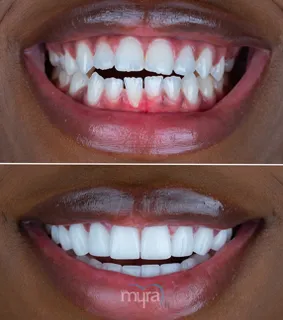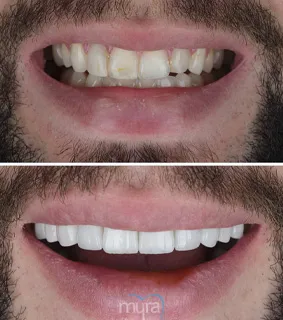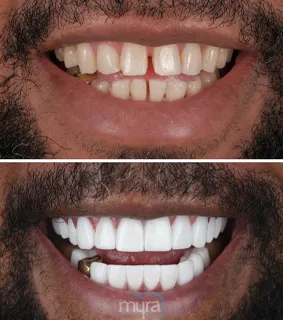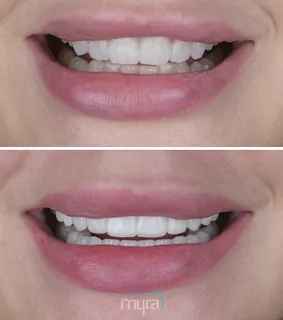A dental crown is a prosthetic that is put on top of a broken or rotten tooth to restore its size, form, strength, and look. The significance of dental crowns rests in their capacity to safeguard weak or broken teeth and restore their function and beauty. Dental provides support to teeth that have undergone root canal treatment or have big fillings and improve general dental alignment.
Dental crowns function by encasing the visible area of a tooth to offer protection, support, and an improved look. Dentists advise their patients to get dental crowns in a variety of scenarios, such as serious tooth decay, tooth fractures or cracks, big fillings, root canal-treated teeth, cosmetic enhancements, and dental bridges or implants.
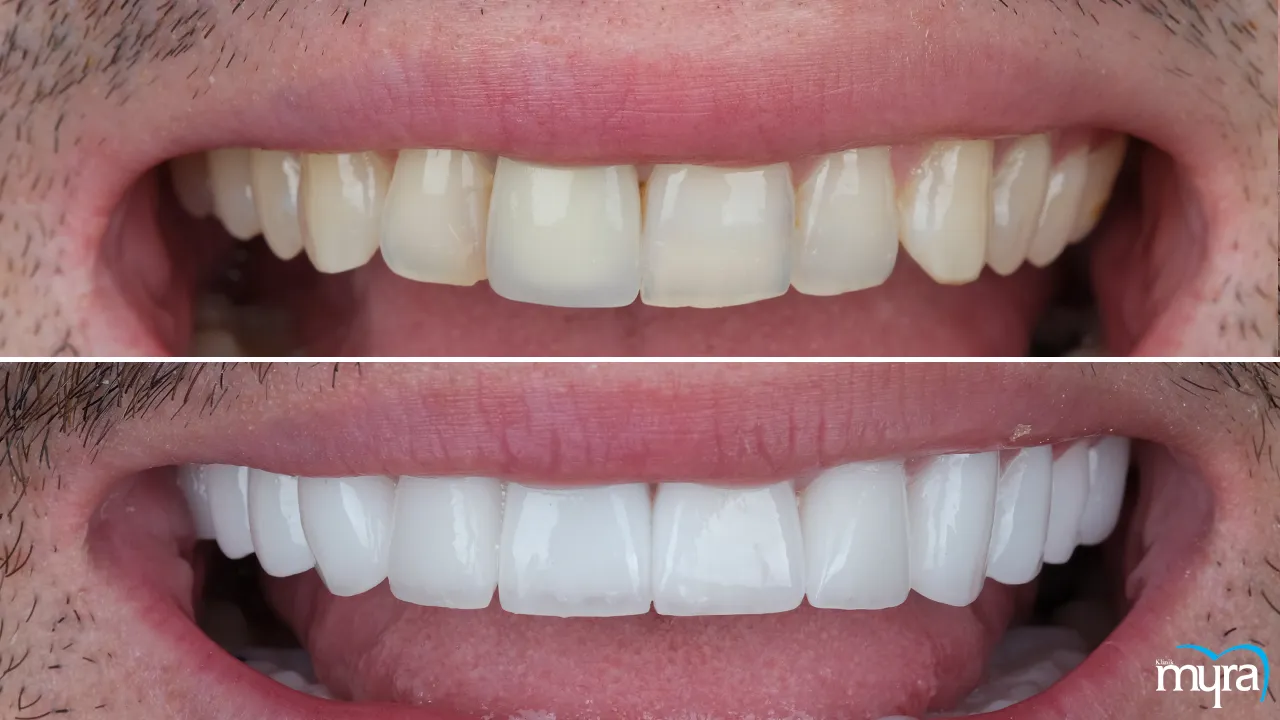
The advantages of dental crowns include protection and longevity, restored functioning, enhanced looks, versatility in managing diverse dental conditions, and comfort. There are a few drawbacks of dental crowns, including the requirement for tooth preparation, the risk of sensitivity or discomfort, and the possibility of crown damage or detachment.
What is a Dental Crown?
A dental crown is a dental prosthetic that is used to restore the shape, size, strength, and look of a broken or destroyed tooth. A dental crown is intended to protect and support the visible area of the tooth above the gum line by completely encasing it.
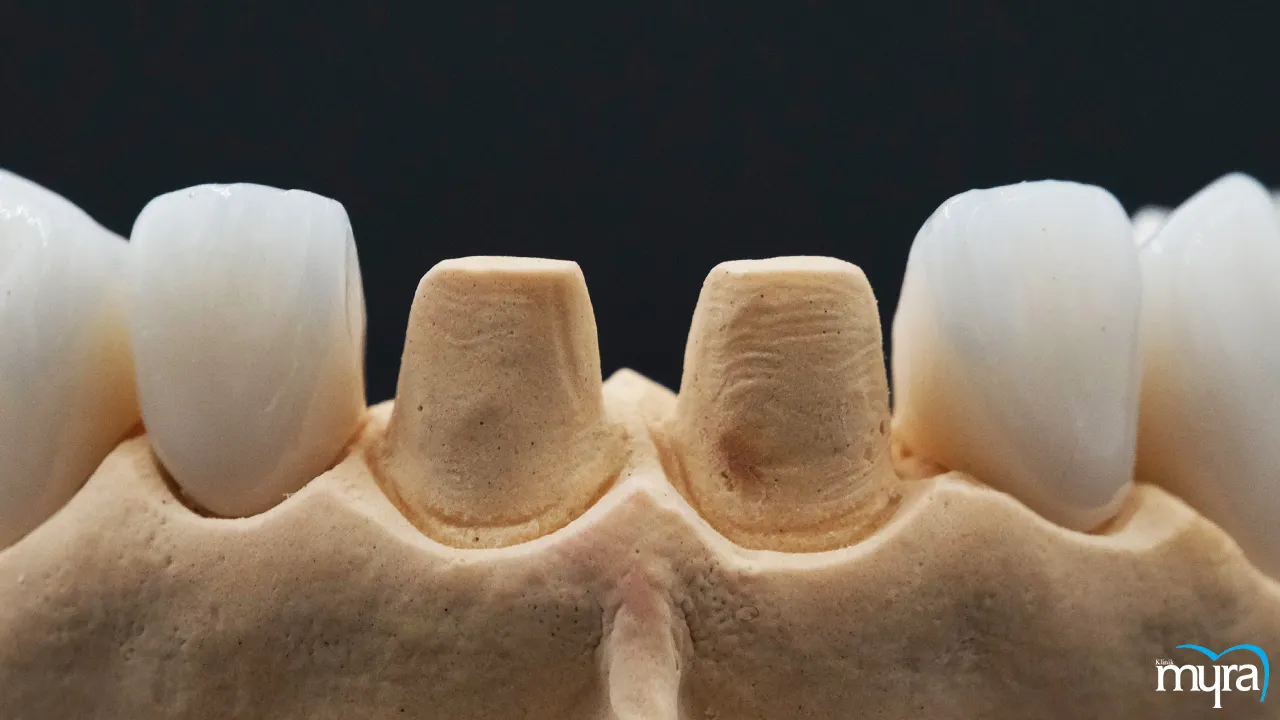
A dental crown is a long-lasting and useful remedy when a tooth is severely decaying, cracked, or damaged. A dental crown helps to prevent additional damage and degradation while restoring the natural function and appearance of the tooth. A crown gives strength and support by covering the entire tooth, letting people bite, chew, and speak easily.
Dental crowns have been around since ancient times. Evidence reveals that gold dental crowns were used to treat damaged teeth in ancient Egypt in approximately 200 AD. Dental crowns composed of various materials, such as gold, silver, and ivory, were used by the ancient Romans and Etruscans.
What is the Importance of Dental Crown?
Dental crowns' importance is to provide essential protection for weak, damaged, or decayed teeth. Dental crowns are important for people who have dental problems since they provide various benefits and treatments. They operate as a strong shield, preventing further deterioration, fractures, and decay by completely encasing the visible section of the tooth above the gum line. The protective role aids in the preservation of natural tooth structure and the avoidance of more intrusive operations such as extractions.
Dental crowns play an important role in dental restoration. A crown is frequently advised treatment when a tooth has substantial decay or damage that is not adequately treated with a simple filling. Dental crowns restore the tooth's structure, size, and function, allowing people to bite, eat, and talk more comfortably. They act as a long-lasting substitute for natural tooth structure, guaranteeing that the tooth endures regular dental functions as well as daily wear and tear.
Dental crowns provide the necessary support to teeth that have had root canal treatment or have massive fillings, in addition to protection and repair. The procedures have the potential to weaken the tooth structure, making it more prone to fracture. Dental crowns fortify the teeth, increasing their durability and lowering the risk of additional injury. The assistance is critical for preserving the strength and stability of the treated teeth.
The effect dental crowns have on appearance is another important factor. Many people who have dental difficulties have severe stains, discolouration, or misshapenness, which impact their smile and self-esteem. Dental crowns are intended to improve the appearance of teeth by concealing flaws. They are made to match the natural colour and shape of neighbouring teeth, creating a more visually pleasing grin. Dental crowns help improve tooth alignment, resulting in a more harmonious dental arch.
Adaptability is another reason for the relevance of dental crowns. Dental crowns handle a wide range of dental issues, making them appropriate for a variety of dental ailments. Dental crowns are a versatile option for decay, fractures, cracks, big fillings, root canal-treated teeth, or the support of dental bridges or implants. They are a beneficial treatment option that responds to the specific demands and requirements of individuals with various dental disorders.
How Does Dental Crown Work?
Dental crowns work with an examination and preparation phase, during which the dentist examines the tooth in question and assesses whether a crown is the best treatment option. They examine the tooth for decay or injury, along with the surrounding gums and neighbouring teeth. X-rays are used to obtain a comprehensive look at the tooth's root and supporting bone structure. The dentist proceeds with the next stages if a crown is considered needed.
The dentist is going to alter the tooth to prepare it for a crown. A small piece of the outer enamel is removed to make room for the crown. The amount of contouring required depends on the type of crown and the oral problem being treated. The goal is to establish a proper fit and have the crown sit nicely with the neighbouring teeth.
An impression is obtained after the tooth has been reformed. The dentist takes a precise impression of the prepared tooth and the surrounding teeth using either a putty-like material or digital scanning technology. The imprint is used to produce a mould from which the dental crown is made. The dentist ensures that the imprint accurately captures the shape and alignment needed for a well-fitting crown.
A temporary crown is placed over the prepared tooth to protect it while the permanent crown is being created in a dental laboratory. The temporary crown generally consists of acrylic or stainless steel and serves as a placeholder until the permanent crown is ready. It protects the tooth, keeps it in position, and provides functional usage until the permanent crown is put in.
The next step is the placement once the dental laboratory completes the fabrication of the permanent crown. The temporary crown is removed, and the dentist examines the final crown's fit, look, and colour match. Any changes that are required to provide an easy bite and flawless integration within the smile are made. The crown is secured in place on the prepared tooth using dental cement after the dentist is pleased. The cement secures the crown to the tooth structure and offers a strong and long-lasting bond.
The dentist executes final tests after the crown is installed to guarantee optimal alignment, bite, and aesthetics. They explain how to care for the dental crown, which includes frequent brushing, flossing, and dental check-ups. Maintain proper oral hygiene practices and avoid biting on hard things to avoid crown damage. A dental crown lasts for many years if properly cared for and maintained, restoring the tooth's function, protecting its structure, and enhancing the patient's smile.
When Does the Dentist Recommend Dental Crowns to Their Clients?
Dentists recommend dental crowns when the patient is having severe tooth decay. A crown is indicated when a tooth has considerable decay that is not properly fixed with a dental filling. The crown assists in restoring the form, strength, and function of the tooth while preventing it from additional harm.
Fractured or damaged teeth are another usual reason for dental crown recommendation. Teeth that are broken or cracked require a crown to provide support and stop the fracture from deepening. The crown covers the broken tooth, strengthening it and restoring its look and usefulness.
Large fillings weaken a tooth's structure, leaving it more inclined to fractures or damage. A dental crown is advisable in such conditions to give additional support and preserve the tooth from future damage.
The fragility and fracture risk of a tooth increase after a root canal method. A dental crown is placed over the treated tooth to avoid it and maintain long-term stability. The crown protects and strengthens the tooth, allowing it to operate correctly.
Dental crowns are advised for aesthetic purposes. They enhance the look of deformed, discoloured, or badly stained teeth, leading to a more aesthetically pleasing smile. The dentist achieves a more consistent and alluring look by crowning the afflicted teeth.
Crowns are utilized in dental bridge treatment to hold the artificial tooth or teeth in place by attaching them to neighbouring natural teeth or dental implants. Crowns are placed on top of dental implants to substitute absent teeth in the case of dental implants. The crowns are the visible, functional, and aesthetically pleasing portion of the implant-supported restoration.
The dental specialists have the expertise and training required to assess the patient's condition, prepare the tooth, and precisely place the crown. They analyse numerous aspects, such as the level of damage, the position of the tooth, and the patient's oral health goals, to select the best treatment approach. Dental crowns are often advised and put on by general dentists, prosthodontists, or restorative dentists.
Are Dental Crowns Durable?
Yes, dental crowns are durable. Dental crowns are made to be strong and long-lasting. Their manufacturing materials, such as porcelain-fused-to-metal, all-ceramic, or zirconia, are noted for their strength and robustness. Dental crowns resist the stresses of typical biting and chewing if properly cared for and maintained.
The durability of a dental crown is determined by numerous factors, including the material used, the position of the crown in the mouth, the patient's oral hygiene practices, and any behaviours or circumstances that exert undue stress on the crown.
Porcelain-fused-to-metal crowns are well-known for their durability and are frequently utilised for molars and rear teeth that require extra strength. All ceramic or all-porcelain crowns are suited for front and back teeth due to their great aesthetics and longevity. Zirconia crowns are noted for their strength and durability, making them excellent for posterior teeth that require extra support.
Keep appropriate oral hygiene practises, such as regular brushing, flossing, and routine dental check-ups, to preserve the longevity of dental crowns. Avoiding practices that put undue strain on the crowns, such as chewing on hard objects or grinding teeth, helps extend their lifespan.
Is Abutment Necessary for Dental Crowns?
No, an abutment is not necessary for Dental Crowns. The need for an abutment is determined by the type of dental crown used and the dental operation being performed.
Dental crowns are installed directly on the prepared tooth without the use of an abutment. Traditional crown techniques include reshaping the teeth first, after which the crown is made to fit over the prepared tooth. The crown itself serves as the repair and the abutment that secures the crown.
An abutment is utilized in certain dental treatments, such as dental implants and implant-supported crowns or bridges. The absent tooth root is substituted by a dental implant, which is surgically inserted into the jawbone. An abutment is attached to the implant after it has merged with the bone. The abutment connects the implant to the dental crown or bridge that is placed on top of it. The crown or bridge is later fastened to the abutment, resulting in a practical and aesthetically pleasing restoration.
What are the Different Types of Dental Crowns?
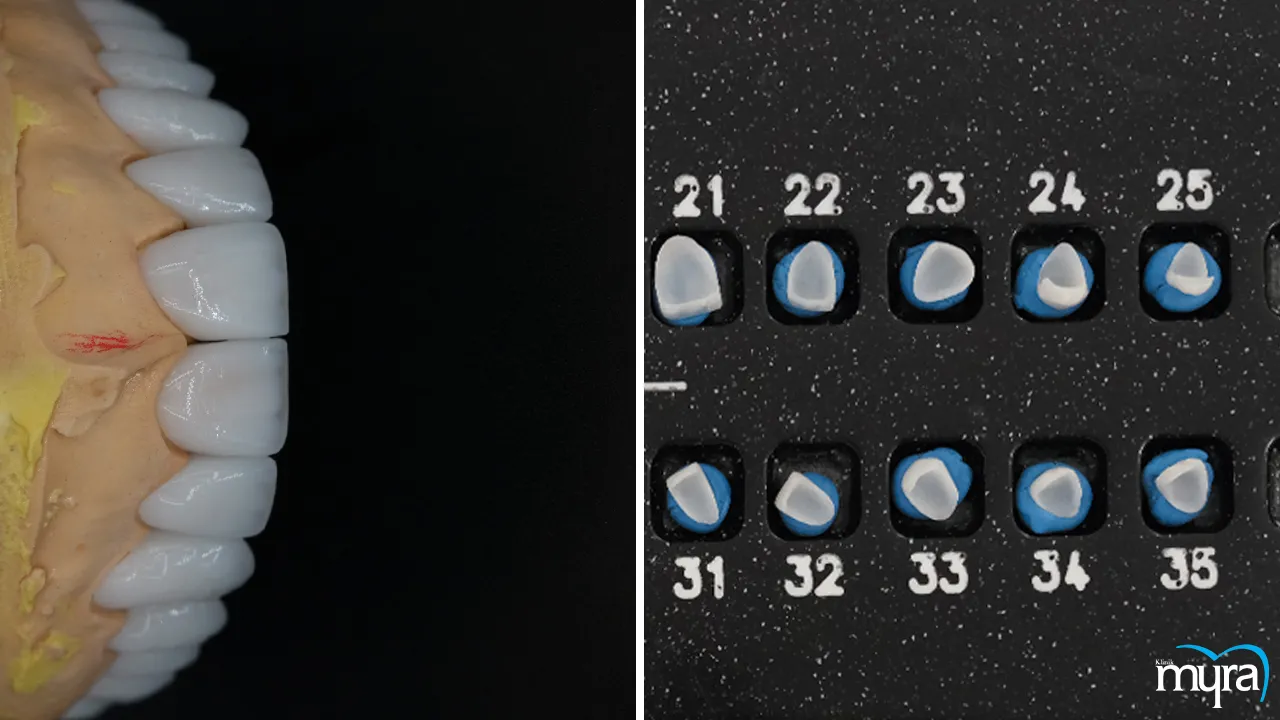
The types of dental crowns are listed below.
- Porcelain-fused-to-metal (PFM) Crown: Porcelain-fused-to-metal crowns feature a metal foundation coated with a coating of porcelain. The metal gives toughness and durability, while the porcelain overlay matches the colour of natural teeth, giving the look of the best natural tooth.
- All-Ceramic or All-Porcelain Crown: All ceramic crowns are done entirely from ceramic or porcelain materials, without any metal components. They are highly aesthetic and are a common alternative for front teeth restoration due to their capability to closely copy the natural look of teeth.
- Zirconia Crown: Zirconia crowns are renowned for their strength and longevity. Zirconia is comprised of zirconium dioxide, a crystalline substance that is appropriate for front and back dental restorations.
- Metal Crown: Metal crowns are manufactured from alloys comprising gold, palladium, nickel, or other base metals. Metal crowns are sturdy and wear-resistant, making them ideal for molars and teeth that are subjected to significant biting forces. Metal crowns are more visible in the mouth due to their shiny colour.
- Stainless Steel Crown: Stainless steel crowns are generally used as temporary crowns for children. They are pre-fabricated crowns that are placed over primary teeth to protect them until permanent teeth form.
- E-max Crown: E-max crowns are a type of all-ceramic crown that is noted for its great strength and looks. They are created from lithium disilicate ceramic and are frequently used for front tooth restoration.
- Porcelain Fused to Zirconia Crown (PFZ): The strength of zirconia is mixed with the natural appearance of porcelain in PFZ crowns. They are appropriate for front and back teeth restorations and give a good mix of aesthetics and durability.
- Composite Crown: Composite crowns are made from dental composite materials. They are often used for temporary crowns or as a more affordable option for restoring teeth with less biting force. These crowns offer versatility and aesthetic appeal, making them fit for a range of dental restoration needs, including among the various types of dental crowns.
What is the Procedure for Dental Crown?
The procedures for dental crowns are the steps below.
- Schedule an appointment with a dentist for an examination and consultation regarding the dental crown process.
- The dentist examines the tooth that requires a crown, takes X-rays to analyse the root and surrounding bone and explains the treatment plan during the consultation.
- The dentist administers local anaesthesia to numb the region around the tooth on the day of the crown treatment. Remove any decay or old filling material from the tooth and reshape it to make room for the crown.
- Take impressions of the prepared tooth and the adjacent teeth with putty-like materials or digital scanning technologies. The imprints are going to be used to create moulds for the dental crowns.
- Place a temporary crown over the prepared tooth to protect it while the permanent crown is produced in a dental laboratory.
- The impressions are used to create the permanent crown at the dental laboratory. The crown is made of materials such as porcelain-fused-to-metal, all-ceramic, or zirconia.
- Return to the dentist for the final crown implantation after the permanent crown is complete. Remove the temporary crown, inspect the final crown for fit and aesthetics, and make any required modifications.
- Bond the final crown to the prepared tooth using dental cement, ensuring a strong and durable attachment.
- Check the bite to ensure proper alignment and make any final adjustments. Polish the crown for a smooth and natural finish.
- Provide aftercare guidelines, including regular oral hygiene practises like brushing, flossing, and dental check-ups, to guarantee the crown's longevity and general oral health.
How Long Does It Take to Install the Dental Crown?
The installation of a dental crown takes two dental appointments and spans a few weeks. The dentist does a full teeth investigation, examines the tooth's condition, and takes X-rays to evaluate the root and surrounding bone during the initial appointment, which lasts 1 to 2 hours. The dentist needs to alter the tooth to establish room for the crown, which requires the removal of decay or existing fillings. Traditional putty-like materials or digital scanning technologies are then used to obtain impressions of the prepared tooth and neighbouring teeth.
The prepared tooth is then protected with a temporary crown while the permanent crown is produced in a dental laboratory. The fabrication procedure, which takes 1 to 2 weeks, involves expert dental specialists creating the custom-made permanent crown based on the impressions taken. Dental crowns are created from various materials, including porcelain-fused-to-metal, all-ceramic, zirconia, and other dental materials, depending on the patient's individual needs and aesthetic choice.
The patient returns for the second appointment once the permanent crown is finished. The dentist takes off the temporary crown and inspects the final crown for fit and aesthetics. Any changes that are required to provide a comfortable bite and flawless integration with the neighbouring teeth are made in the process. The finished crown is then firmly glued to the prepared tooth using dental cement, resulting in a strong and long-lasting bonding.
What are the Advantages of Dental Crown Over Other Types of Dental Restoration?
The advantages of dental crown over other types of dental restoration are listed below.
- Full Tooth Coverage: Dental crowns completely cover the visible area of the tooth, from the gumline to the biting surface. The extensive coverage protects and supports a weakening or damaged tooth.
- Strength and Durability: Dental crowns are made of strong materials such as porcelain-fused-to-metal, all-ceramic, or zirconia, which makes them extremely durable and able to endure regular biting and chewing forces. Their durability assures that they are a long-lasting dental restoration.
- Versatility: Dental crowns are adaptable and utilised for a variety of dental applications. Dental crowns are used to restore severely decaying, cracked, or discoloured teeth, and to protect and strengthen teeth following root canal therapy.
- Natural Appearance: Modern dental crowns are custom-made to match the colour, size, and shape of the natural teeth, resulting in an aesthetically beautiful and natural grin. They are a great option for restoring front teeth.
- Improved Functionality: Dental crowns improve tooth functionality by restoring the normal shape and size of a broken tooth. They provide normal oral function by allowing the patient to chew, speak, and bite comfortably.
- Stain Resistance: Certain dental crown materials, such as porcelain or zirconia, are extremely stain-resistant. The feature guarantees that the crown resists discolouration and retains its natural beauty throughout time.
- Protection for Weak Teeth: Dental crowns preserve teeth that have had major dental operations such as massive fillings. They protect the tooth's structural integrity by preventing further damage and fracture.
- Compatibility with Dental Implants: Dental crowns are used in conjunction with dental implants to restore lost teeth. They are the visible and functional component of an implant-supported restoration, acting as a natural-looking substitute for a lost tooth.
- Minimal Tooth Removal: Dental crowns require less tooth removal than other types of dental restorations, such as dental bridges. It means that during the preparation process, more of the native tooth structure is kept.
- Comfortable and Non-Invasive: The technique for placing a dental crown is generally simple and well-tolerated by the majority of individuals. Dental crowns last for many years if properly cared for and maintained.
What are the Disadvantages of Dental Crown from Other Types?
The disadvantages of dental crown from other types are listed below.
- More Tooth Removal: Dental crown preparation frequently requires greater tooth structure removal than alternative treatments such as dental veneers or composite bonding. The strength of the tooth decreases as a result.
- Multiple Appointments: The procedure for receiving a dental crown entails two dentist sessions, with a few weeks between the first and second appointments. It is troublesome for those looking for a more fast repair solution.
- Cost: Dental crowns are more expensive than other types of restorations, such as dental fillings or composite bonding. The cost of a crown is based on the material used and the complexity of the treatment.
- Potential Sensitivity: People have temporary tooth sensitivity to hot or cold temperatures after receiving a dental crown because of the preparation of the tooth and the placement of the crown. The sensitivity normally fades within a short period.
- Risk of Crown Fracture: Dental crowns are quite durable, but there is a chance of crown fracture, particularly if the individual has habits such as biting on hard objects or grinding their teeth.
- Allergic Reactions: Certain materials used in dental crowns, including metals in porcelain-fused-to-metal crowns, cause sensitivities or allergies in some people. Allergic reactions or gum irritation occur as a result.
- Aesthetics in Some Cases: Dental crowns give teeth a natural-looking appearance, but some varieties, notably metal-based crowns, are not as visually acceptable as all ceramic or porcelain crowns, especially for front teeth restorations.
- Potential for Decay: There is a minor danger of deterioration occurring beneath the crown if the crown's borders are not well-sealed to the tooth surface.
- Temporaries: Temporary crowns placed between appointments are not as lasting or aesthetically pleasing as final crowns, which causes moderate annoyance.
- Not Reversible: The procedure of preparing a tooth for a dental crown is irreversible. It means that the tooth always needs a crown or other type of restoration to safeguard and support it.
How Long Would the Dental Crown Last?
Dental crowns have a lifespan of 5 to 15 years when properly cared for and maintained. The timeframe includes a plethora of elements that influence the durability of dental restorations. The variety of materials used to make dental crowns has a considerable impact on their lifetime. Metal crowns, which are frequently made of alloys such as gold or silver, are extremely durable and corrosion-resistant, contributing to extended lifespans. Resin crowns do not last as long because of their susceptibility to wear and chipping.
Oral hygiene procedures that are meticulously followed directly contribute to the long-term integrity of dental crowns. Plaque and harmful germs are prevented from accumulating around the crown and the tooth's underlying structure by regular brushing, flossing, and rinsing. Individuals help to extend the life of the crown by preventing decay and gum disease.
The crown's actual placement within the mouth determines its longevity. Crowns in high-pressure zones, such as chewing molars, are subjected to more mechanical stress than those in less demanding locations. The distinction causes wear differences and, as a result, affects how long a crown lasts.
Biting habits and behaviours have a substantial impact on the longevity of dental crowns. Individuals who grind their teeth or clench their jaws habitually apply excessive pressure on the crown, causing premature deterioration. These motions cause cracks, fractures, or rapid wear, reducing the crown's estimated lifespan.
The fit of the crown and the quality of the glue used during placement are factors in its life. A well-fitted crown with strong cement leaves little room for bacterial infiltration and decay formation beneath the crown, increasing its life.
Dietary habits have an effect on the crown's lifespan. A diet high in hard or sticky foods increases the chance of crown chipping or fracture, especially for materials prone to such damage. Premature wear is often caused by biting into hard objects such as ice or opening goods with the teeth.
Regular dental check-ups allow for the early discovery of any problems, allowing for fast management before problems worsen. Dentists have the ability to track the crown's condition and provide recommendations to extend its life.
What are the Possible Complications of Having Dental Crowns?
The possible complications of having dental crowns are listed below.
- Allergic Reactions: Individuals are prone to allergic reactions to the materials used in dental crowns in rare situations, causing discomfort, irritation, or other mouth symptoms.
- Infection Around the Crown: Infections form in the gums or tissues surrounding a dental crown, resulting in pain, swelling, and the need for treatment.
- Gum Disease: Poor oral hygiene leads to gum disease such as gingivitis around the base of the crown, compromising its stability and requiring removal if not addressed promptly. The inflammation caused by gingivitis weakens the supporting tissues, leading to discomfort and the need for further dental intervention
- Loose Crowns: Crowns become loose owing to a lack of adhesive or underlying dental problems. A loose crown causes pain, bacterial infiltration, and other issues.
- Sensitivity: Patients have temporary sensitivity to temperature fluctuations or specific foods following crown placement. Sensitivity normally goes away, but it is uncomfortable at first.
- Crown Fractures: Dental crowns are prone to chipping or fracture if pushed to undue strain.
- Cavities: The crown and the underlying tooth become compromised if the crown's margins are not adequately sealed or if oral hygiene is neglected.
- Ill-Fitting Crowns: Crowns that are improperly fitted or don't match the natural bite lead to discomfort, problems with chewing, and other bite-related issues.
- Chipped Crown: Crowns chip if bitten on harsh surfaces or foods.
- Dark Line on the Gums: A dark line develops evident at the gum line of a capped tooth over time, especially if a metal-based crown is utilised. Dark lines on the gums have an effect on the appearance of the grin.
How Does Dental Crown Affect Your Teeth Sensitivity?
Dental crowns impact teeth sensitivity, particularly in the immediate aftermath of the procedure. Part of the placement of a dental crown is the removal of a piece of the tooth's outer coating, known as enamel, to accommodate the crown's structure. Enamel acts as a protective barrier for the tooth's underlying layers. The removal of the protective covering reveals the dentin, a softer tissue underlying the enamel that contains microscopic channels known as dentin tubules. These tubules are directly connected to the tooth's nerve.
Teeth become more sensitive to external stimuli as a result of exposed dentin tubules. Hot and cold temperatures, and even chewing pressure, are conveyed more directly to the nerve of the tooth via tubules. The increased sensitivity is most noticeable soon after crown insertion and lasts for a short time as the tooth adapts to its new shape.
The sensitivity is temporary and fades over time. The heightened susceptibility of the nerve to external stimuli progressively decreases as saliva covers the exposed dentin tubules and the tooth undergoes a natural remineralization process. Individual experiences with sensitivity differ depending on factors such as the type of crown, the quantity of enamel removal, and individual pain levels.
Several techniques are used to manage post-crown sensitivity. Excessive exposure to severe temperatures is reduced by avoiding extremely hot or cold foods and beverages. Using sensitive-tooth toothpaste and practising careful oral hygiene with a soft-bristle toothbrush are helpful methods. Dentists recommend desensitising treatments or remedies if the sensitivity persists or is uncomfortable.
How Does Dental Crown Affect the Food You Eat?
Tenderness in the treated area is felt after having a dental crown, leading to an initial preference for softer foods. Avoiding sticky foods for the first 24 hours after receiving a permanent crown is advised. Normal eating habits, including the consumption of a wide variety of meals and the maintenance of regular dental hygiene practices, are allowed to be resumed after that period.
The placement of a dental crown has an impact on eating habits, owing to the sensitivity and soreness that accompany the treatment. The effect is caused by changes made to the treated tooth and its surrounding gum area. The immediate aftermath of having a dental crown frequently causes discomfort, making biting and chewing somewhat difficult. Stick to softer foods in the days following crown implantation because of the sensitivity.
Soups, mashed vegetables, yoghurt, and smoothies are easier on sensitive areas, reducing discomfort and facilitating the healing process. The short-term adjustment phase helps the mouth heal while preventing undue stress on the previously treated area.
The comfort level while eating must slowly increase as the initial discomfort passes and the mouth becomes more acclimated to the freshly implanted crown. Follow the usual oral hygiene practises even after having a dental crown. Continue brushing and flossing as directed by the dentist to avoid any issues around the crown, such as gum irritation or deterioration around the crown's edges.
How Does Dental Crown Affect Your Confidence?
Dental crowns boost self-confidence by improving the aesthetics of the smile, concealing dental imperfections, and allowing the ability to speak, eat, and laugh with greater comfort and assurance. The capacity of a dental crown to improve the looks of a smile demonstrates the transformative influence of a dental crown on confidence. Self-consciousness is a result of dental flaws such as discolouration, malformed teeth, fissures, or chipping. A dental crown skillfully masks these problems, creating a more harmonious and appealing smile. The change successfully boosts confidence in one's looks.
The natural-looking effect of contemporary dental crowns boosts confidence even further. Dental crowns mimic the colour, texture, and translucency of natural teeth by using materials such as porcelain or ceramic. A crown blends in with existing teeth, resulting in a united and authentic smile that boosts self-esteem.
Dental crowns boost confidence by providing a practical restoration. A tooth that is affected by decay, injury, or wear can make chewing, speaking, or even smiling difficult, leading to discomfort or uncertainty. Dental crowns effectively restore the normal function of these teeth, providing the stability required for normal daily activities. The newfound ease has a huge impact on interactions with others, bolstering confidence in social situations.
Having a dental crown instils personal empowerment aside from the concrete benefits. Addressing dental issues and actively participating in the oral health journey creates a sense of responsibility and self-care. Empowerment leads to increased confidence in one's choices and overall well-being.
Long-term confidence is enhanced by the endurance of dental crowns. The awareness that one has a strong and long-lasting dental restoration alleviates anxiety about potential complications, allowing people to focus on the present and future optimistically.
Getting a tooth crown requires discussion and teamwork, which boosts confidence. Open communication with a dentist about objectives and concerns ensures a personalised treatment plan that is matched with individual goals. The collaborative method makes it easier to trust the treatment process and the results that are expected.
What Are the Materials Used in Making Dental Crowns?
The materials used in making dental crowns are listed below.
- Zirconia Crowns: Zirconia crowns are made of zirconium dioxide, a robust and long-lasting ceramic substance. Zirconia crowns are known for their remarkable strength, which makes them suitable for withstanding chewing stresses, particularly on back teeth. Their translucent nature provides for a more natural appearance, making them a popular choice for both front and back teeth.
- Porcelain or Ceramic Crowns: Porcelain or ceramic crowns are well-known for closely replicating the colour, texture, and translucency of genuine teeth. They are great for noticeable front teeth due to their aesthetic appeal. Porcelain or ceramic crowns are valued for their ability to fit in with the existing teeth, enhancing the overall smile.
- Porcelain-Fused-to-Metal Crowns: The strength of a metal foundation is combined with the natural appearance of porcelain in porcelain-fused-to-metal crowns. The metal substructure ensures endurance, while the porcelain overlay is aesthetically attractive. Note that the porcelain layer wears down with time, compromising the crown's appearance.
- Metal Crowns: Metal crowns are made from metal alloys such as gold, silver, and palladium. Metal crowns are known for their outstanding endurance and robustness, especially in rear teeth that are subjected to significant chewing forces. Their metallic appearance renders them unsuitable for front teeth that are visible.
How Much Does a Dental Crown Procedure Usually Cost?
Dental Crown procedures usually cost from €140 to €300 in Turkey. The cost of the procedure is influenced by the dentist's experience and reputation. Given the perceived quality of their service, dentists with significant expertise and a great reputation charge higher prices. The total cost increase if any additional procedures are necessary before the crown is going to be installed such as root canal treatment or gum therapy.
The type of crown material chosen is a major cost determinant. Metal crowns are less expensive than all ceramic or porcelain-fused-to-metal crowns, owing to variations in material costs and fabrication complexity. The geographical area of residence significantly affects the overall cost. Dental prices in metropolitan areas and places with greater cost of living tend to be higher than in less urban or more cost-effective locations.
Dental insurance coverage needs to be considered. There are dental insurance policies that cover a portion of the dental crown operation, reducing out-of-pocket costs. The level of coverage varies greatly, and some plans do not cover the surgery at all.
Additional ancillary charges, such as consultations, x-rays, and follow-up appointments, add to the overall cost. Talk about the potential charges with the dentist ahead of time to know exactly what to expect.
Certain dentists provide bundle deals for several crowns or offer discounts for certain payment methods. Financing options are available, making dental crown surgery more affordable and allowing you to spread the cost over time.
How Does Dental Crown Compare from Veneers?
A dental crown is a full-coverage restoration that covers the visible area of a tooth above the gum line. A dental crown is useful and aesthetically pleasing. Crowns are used to repair severely damaged teeth that have had root canals or have substantial decay or fractures. Crowns enhance the appearance of teeth in addition to providing structural support. Veneers are thin shells made of porcelain, that are put to the front surface of teeth. Crowns are used for cosmetic upgrades, such as removing stains, small chips, or unusual shapes.
The procedure of tooth preparation distinguishes the treatments. Dental crowns require a more thorough tooth reduction. The tooth is altered to accommodate the crown's thickness, which requires the loss of a considerable percentage of the tooth's structure. Veneers require just minor tooth reduction. A tiny layer of enamel from the front surface is removed to facilitate correct veneer application. The cautious technique makes veneers a desirable option for cosmetic improvements that do not require significant changes to the tooth structure.
The coverage that each restoration offers is another distinction. Dental crowns safeguard and fortify the visible portion of the tooth by covering the entire visible portion of the tooth. Veneers simply cover the front surface of the teeth. They do not offer the same level of structural support as dental crowns, despite the fact that they improve the appearance.
Dental crowns and veneers excel in various areas of cosmetic enhancement. Dental crowns are utilised for functional restoration, and while they improve looks, their primary focus is on providing strength and support to weakened teeth. Dental Veneers are developed to correct small cosmetic faults and create a more attractive grin. They are successful when the underlying tooth structure is healthy and the main goal is to improve appearance.
What Are the Signs that Indicate a Dental Crown May Need Replacement?
The signs that indicate a dental crown may need replacement are listed below.
- Tooth or Gum Pain: Persistent toothache or discomfort in the area around the crowned tooth indicates an underlying condition, such as infection or nerve damage. Gum discomfort or inflammation indicates crown concerns.
- Dental Crown Fracture: The dental crown itself must be replaced if there are any obvious cracks, breaks, or chips. Damaged crowns can weaken their function and lead to other dental issues.
- Loose Crown: A loose or shifting dental crown must be an indication of a poor fit or compromised cement. A loose crown causes discomfort and exposes the underlying tooth to injury.
- Change in Tooth Appearance: The cosmetic qualities of the crown deteriorate if the crowned tooth's colour deviates greatly from surrounding teeth or if there are obvious changes in its shape.
- Noticeable Wear and Tear: Chewing pressures and frequent use cause dental crowns to wear and tear over time. Replacement is necessary if the crown demonstrates symptoms of erosion, flattening, or thinning.
What Are the Things You Can Do with a Dental Crown?
The things you can do with a dental crown are listed below.
- Chewing: Dental crowns strengthen and function damaged teeth, allowing regular chewing and eating.
- Speaking: Crowns assist in the maintenance of appropriate tooth alignment, resulting in clear and confident speech.
Can Dental Crowns Replace Missing Teeth?
No, dental crowns do not replace missing teeth. Dental crowns are used to restore and safeguard a damaged or diseased tooth's current form. Dental crowns are utilized to reinforce, support, and enhance the look of natural teeth. Crowns are not a viable choice for restoring absent teeth.
Dental implants, bridges, or dentures are frequently employed to restore missing teeth. A titanium post is surgically implanted into the jawbone to act as a synthetic tooth root, on which a prosthetic crown is affixed. Dental bridges are made up of numerous crowns that are joined together, with the end crowns being placed over existing teeth or implants to fill the gap left by the lost tooth. Dentures are detachable dental appliances that replace a number of lost teeth.
Dental crowns are useful for repairing damaged teeth, but they are not meant to replace lost teeth. Consult with the dentist about acceptable replacement choices in order to restore both the function and aesthetics of the smile.
Are There Any Alternatives to Dental Crowns for Restoring Damaged Teeth?
Yes, there are alternatives to dental crowns for restoring damaged teeth. The choice of treatment depends on factors such as the degree of damage, the position of the tooth, aesthetic considerations, and the patient's preferences. There are a number of substitute procedures that offer varying degrees of reconstruction and maintenance of the natural tooth structure, even though dental crowns are a typical and reliable option for recovering teeth that have suffered huge damage or decay.
Dental veneers are thin shells that are custom-made and attached to the front surface of teeth. They are used aesthetically to improve the appearance of teeth with minor flaws such as chips, cracks, or discolouration. Veneers are seen to be a more conservative option than dental crowns since they need less tooth reduction while delivering significant aesthetic enhancement.
Inlays and onlays are restorations used to restore moderately damaged teeth, such as bigger cavities or fractures. They are constructed to fit within or over the cusps of the tooth and are an alternative to full dental crowns. Inlays and onlays take a more conservative approach by retaining more of the native tooth structure.
Dental bonding is the process of repairing tiny chips, fractures, or cavities with a tooth-coloured resin material. Dental bonding offers a minimally intrusive, cost-effective solution for modest repairs while maintaining a natural appearance, even if it is not appropriate for extensive damage.
Orthodontic treatments such as dental braces or clear aligners are explored in circumstances where teeth are misaligned or have minor cosmetic problems. Orthodontic treatment improves the appearance and function of damaged teeth without the need for expensive repairs.
Small to moderate cavities or damage is capable of being repaired using tooth-coloured composite fillings. The fillings preserve more of the tooth's structure and fit in flawlessly with natural teeth compared to dental crowns.
Dental implants and bridges are feasible options for severely damaged or missing teeth. A titanium post is surgically implanted into the jawbone and a prosthetic crown is attached. Bridges are used to restore lost teeth by using neighbouring teeth as support.
Can Dental Crowns Cause Tooth Sensitivity?
Yes, dental crowns cause tooth sensitivity. Tooth sensitivity is a side effect of receiving a dental crown, especially in the immediate aftermath. The sensitivity is temporary and goes away as the tooth adjusts to the new crown. The sensitivity is induced by a variety of variables relating to the crown placement procedure.
A piece of the native tooth structure is removed during crown preparation to make room for the crown. The piece of the native tooth exposes the dentin, a sensitive layer underlying the enamel that causes soreness. It results in improper occlusion or bite, resulting in sensitivity during biting or chewing if the crown fit is not correctly matched.
Gum sensitivity occurs as a result of gum manipulation during the treatment. The sensitivity causes discomfort, especially while eating or drinking hot or cold foods. Dental crowns diminish as the tooth and surrounding tissues adapt while early sensitivity is common. Prolonged or worsening sensitivity suggests concerns such as an inappropriate crown fit, faulty bonding, or underlying dental abnormalities. Seeing a dentist is helpful for determining the source of the sensitivity and ensuring general dental comfort.






